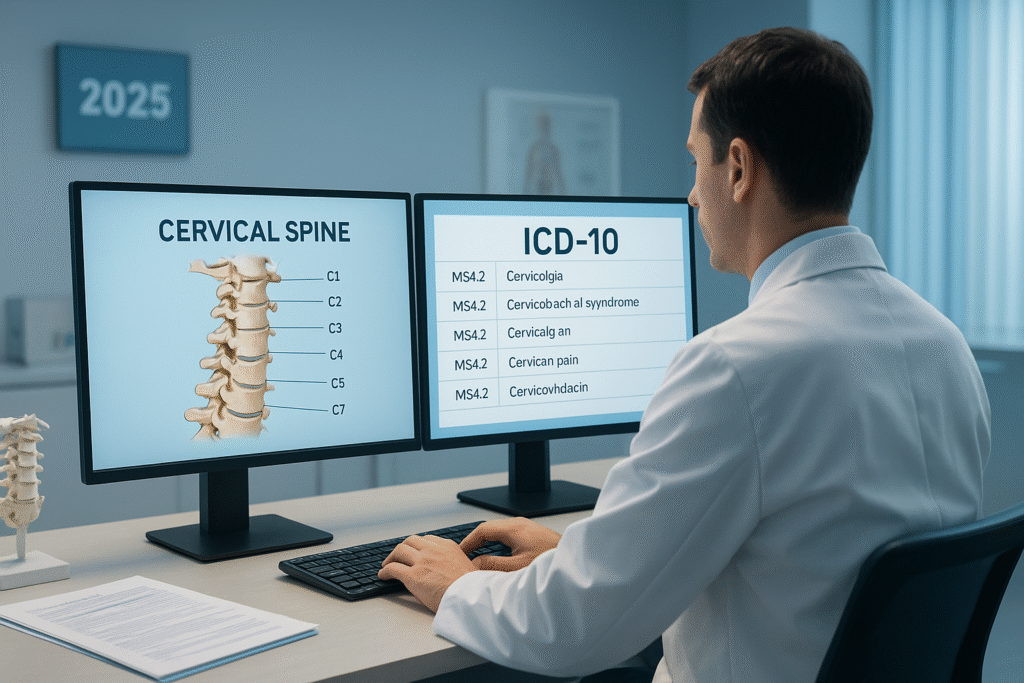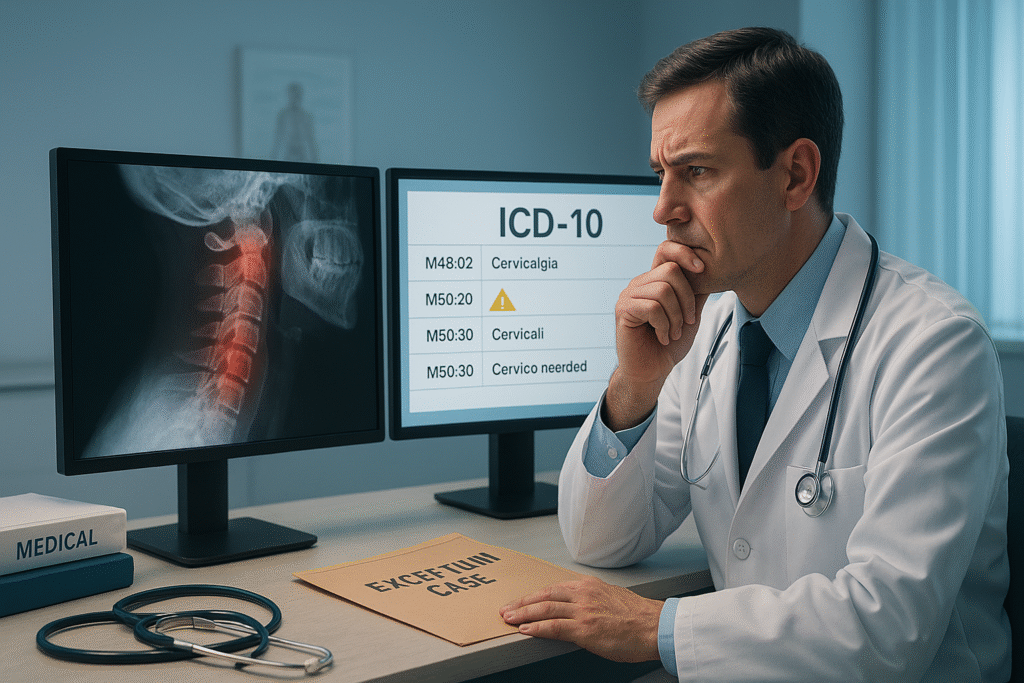
Introduction
Cervical pain, commonly referred to as neck pain, is one of the leading complaints in medical offices across the globe. For healthcare professionals, accurate documentation and coding of this condition are essential—not just for insurance reimbursement, but also for statistical tracking, treatment planning, and compliance. In this comprehensive guide, we dive deep into the ICD 10 code for cervical pain, breaking down its usage, exclusions, documentation requirements, and how recent updates affect your clinical workflow in 2025.
What Is the ICD 10 Code for Cervical Pain?
M54.2, Cervicalgia, is the ICD 10 code for cervical discomfort. This diagnosis code is used to identify unspecified neck pain and is found under the ICD-10 category “Dorsalgia,” which covers back-related conditions. Cervicalgia refers specifically to pain originating from the cervical spine (C1 to C7), commonly resulting from poor posture, muscle strain, or underlying degenerative conditions.
As long as no other more particular cause of neck discomfort is found, M54.2 is regarded as a billable and specific diagnosis code, which means it can be utilized independently for reimbursement.
Clinical Applications of the ICD 10 Code for Cervical Pain
Understanding the application of the ICD 10 code for cervical pain helps ensure clinical accuracy and optimal reimbursement. Usually, this code is applied when:
- The source of the neck pain is non-specific or undiagnosed
- Pain is not linked to a disc disorder, trauma, or nerve impingement
- The patient reports localized pain without radiation, numbness, or tingling
- The condition is acute or subacute, without chronic structural abnormalities
Common settings where M54.2 might be applied include:
- Primary care clinics
- Chiropractic offices
- Physical therapy sessions
- Urgent care centers
- Occupational health facilities
When Cervical Pain Should Not Be Treated with the ICD 10 Code

It’s critical to avoid misusing the ICD 10 code for cervical pain when a more accurate, specific diagnosis exists. According to ICD-10-CM Excludes1 notes, M54.2 should not be coded together with:
- M50 series – Cervical disc disorders with or without radiculopathy
- M54.12 – Cervical radiculopathy
- S13.4XXA – Cervical spine ligament sprain
- F45.41 – Psychogenic pain disorders
These exclusions exist to prevent duplication and miscoding, which could result in insurance claim denials or incorrect patient records.
For example, if a patient’s neck pain is due to a herniated cervical disc compressing a nerve root, you should use a code from the M50. series*, not M54.2.
Coding Example Scenarios
To illustrate correct usage of the ICD 10 code for cervical pain, consider the following case examples:
Example 1: Correct Usage
Patient reports neck pain following poor sleeping posture. No history of trauma, neurological symptoms, or disc pathology is present.
Code: M54.2 – Cervicalgia
Example 2: Incorrect Usage
Patient has confirmed cervical disc herniation with radiating pain into the arm.
*The correct code for cervical disc disease with radiculopathy in the mid-cervical region is M50.12.
By avoiding generalization and using the ICD 10 code for cervical pain only when appropriate, healthcare providers can ensure cleaner claims and better patient outcomes.
Documentation Requirements for 2025

As of 2025, the Centers for Medicare & Medicaid Services (CMS) and major payers emphasize detailed clinical documentation. For M54.2 to be considered medically necessary, the following elements should be clearly documented:
- Onset of symptoms (acute, subacute, chronic)
- Pain characteristics (dull, sharp, throbbing, intermittent)
- Location and laterality (unilateral vs bilateral)
- Physical exam findings (range of motion, tenderness, guarding)
- Absence of red flags (no trauma, radiculopathy, infection)
Incomplete documentation can lead to audits, denials, or down-coding. Remember, the ICD 10 code for cervical pain is a general diagnosis and should be supported with evidence that more specific conditions have been ruled out.
Reimbursement Considerations
Using the ICD 10 code for cervical pain correctly has direct financial implications. In 2025, reimbursement models are increasingly outcome- and documentation-driven. Several new policies affect how codes like M54.2 are evaluated:
- NOPAIN Act incentives promote the use of non-opioid pain treatments, such as physical therapy or acupuncture, for neck pain.
- Physician Fee Schedule Updates now require more accurate coding to justify evaluation and management (E/M) billing levels.
- Pre-authorization requirements may flag M54.2 as “nonspecific,” triggering delays unless documentation supports medical necessity.
Therefore, using the ICD 10 code for cervical pain without proper substantiation may lead to reimbursement delays or denials.
ICD-10 Updates and Stability in 2025
Good news for coders: the ICD 10 code for cervical pain remains unchanged in the 2025 ICD-10-CM code set. This continuity ensures that providers and billing teams do not need to retrain or restructure EMR templates for this specific diagnosis. However, payers are looking more closely at supporting clinical notes, especially with AI-assisted claim audits on the rise.
Best Practices for Accurate Coding
To ensure you’re using the ICD 10 code for cervical pain accurately, follow these tips:
- Always document thoroughly—not just symptoms, but context, exam findings, and any diagnostics.
- Avoid defaulting to M54.2 if a more precise code exists (disc, nerve, trauma).
- Use modifiers and CPT codes appropriately alongside M54.2 to support procedures (e.g., physical therapy, imaging).
- Follow payer policies on pre-authorization, especially for chronic neck pain.
- Check claims frequently for abuse or overuse of general codes such as M54.2.
Following these guidelines will reduce claim rejections, increase billing accuracy, and ensure better patient tracking.
Comparing M54.2 With Similar Codes
| ICD-10 Code | Description | When to Use |
|---|---|---|
| M54.2 | Cervicalgia, or discomfort in the neck | Nonspecific neck discomfort without trauma or radiculopathy |
| M54.12 | Cervical radiculopathy | Pain with nerve root symptoms (tingling, numbness) |
| M50.1 | Radiculopathy associated with cervical disc problems | Neck pain with nerve impact and disc pathology verified |
| S13.4XXA | Cervical spine sprain (initial encounter) | Traumatic injury to ligaments of the neck |
| M47.812 | Spondylosis devoid of radiculopathy or myelopathy | Neck stiffness brought on by degenerative changes |
Choosing the correct code avoids redundancy and ensures you remain compliant with ICD-10 coding rules.
ICD 10 Code for Cervical Pain in Physical Therapy and Chiropractic Care

The ICD 10 code for cervical pain is commonly used in rehabilitative settings. For physical therapists and chiropractors, M54.2 is often the entry-level code for initiating treatment. However, documenting progress and evaluating therapy outcomes is critical.
- For initial visits, M54.2 may be used with CPT codes like 97110 (therapeutic exercise) or 97140 (manual therapy).
- If treatment extends or changes due to new findings, update the diagnosis code accordingly (e.g., shift to M50.* if imaging reveals disc herniation).
Insurance companies may request progress notes and objective measures (pain scales, ROM) to justify continued treatment under M54.2.
Conclusion
The ICD 10 code for cervical pain plays a vital role in today’s healthcare documentation landscape. While M54.2 provides a useful catch-all for non-specific neck pain, it should be applied carefully, with attention to documentation, clinical accuracy, and coding exclusions.
Frequently Asked Questions (FAQs)
1. What is cervical pain’s ICD 10 code?
For cervical pain, the ICD 10 code is M54.2, Cervicalgia. It is used to indicate nonspecific neck pain without neurological involvement or a known structural cause such as disc herniation or trauma.
2. When should I use M54.2 instead of a more specific code?
Use M54.2 only when the neck pain is generalized and not caused by a disc disorder, radiculopathy, or injury. If the cervical pain has an identifiable cause (e.g., M50.12 for disc-related radiculopathy), the more specific code should be used instead of the ICD 10 code for cervical pain.
3. Is M54.2 a billable ICD-10 code?
Yes, M54.2 is a billable diagnosis code under the ICD-10-CM coding system. However, it must be supported by clinical documentation, and it cannot be used alongside certain other codes due to exclusion rules.
4. What documentation is needed to support the ICD 10 code for cervical pain?
To support M54.2, clinicians should document the following:
- Onset and duration of the pain
- Pain characteristics (e.g., sharp, dull, intermittent)
- Physical findings (e.g., ROM limitations, tenderness)
- Absence of red flags or neurological symptoms
This helps ensure medical necessity for the use of the ICD 10 code for cervical pain.
5. Can I use M54.2 and M50.12 together?
No. According to ICD-10 Excludes1 guidelines, M54.2 and M50.12 should not be used together. If the pain is due to a disc disorder with radiculopathy, M50.12 is the correct and more specific code.
6. In 2025, would the ICD 10 code for cervical discomfort still be applicable?
The 2025 ICD-10-CM code update does not alter the validity of the ICD 10 code for cervical discomfort (M54.2). Providers should still follow updated documentation and reimbursement requirements to use it correctly.
7. How does M54.2 affect insurance reimbursement?
While M54.2 is billable, insurance payers may scrutinize it more heavily due to its general nature. To avoid claim denials, ensure detailed documentation supports the diagnosis and that no more specific code would be more appropriate than the ICD 10 code for cervical pain.
8. Can physical therapists use the ICD 10 code for cervical pain?
Yes, physical therapists frequently use M54.2 as the initial diagnosis for neck pain. However, it’s essential to reassess and update the code if further evaluation reveals a more precise cause of cervical pain.
9. Is cervicalgia the same as cervical radiculopathy?
No. Cervicalgia (M54.2) refers to generalized neck pain without nerve involvement, while cervical radiculopathy (M54.12) involves nerve root compression causing symptoms like numbness or tingling down the arms.
10. Can chiropractors use the ICD 10 code for cervical pain in their billing?
Of course. M54.2 is frequently used by chiropractors to record nonspecific cervical discomfort and alleviate neck pain. As with all providers, it’s important they document exam findings and exclude structural or neurological causes when using the ICD 10 code for cervical pain.
